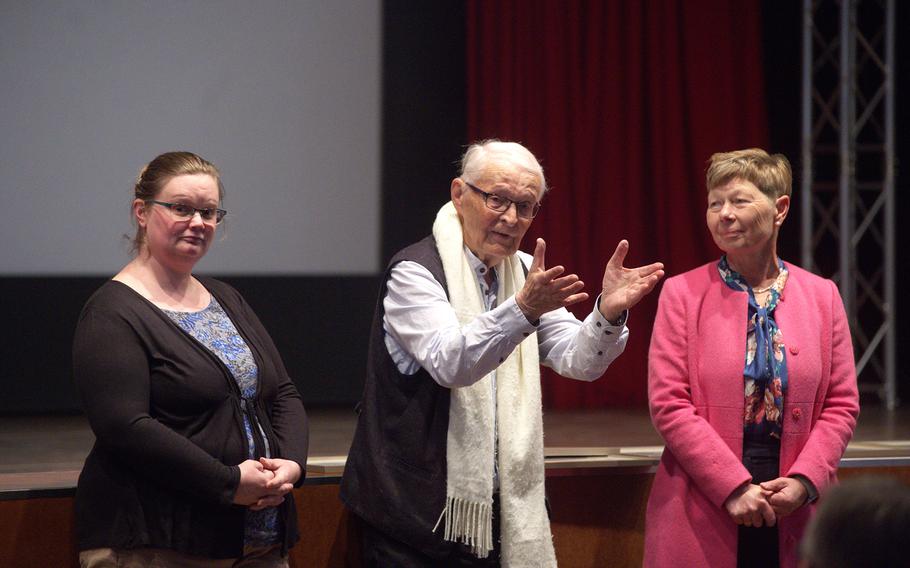
German filmmakers Kerstin Schmidt, left, and Thilo Pohle answer questions from the audience after screening their World War II documentary "And Now Show that You are One People!" at U.S. Army Garrison Ansbach, Germany, on April 25, 2025. The film was shown at the base's Bismarck Movie Theater to commemorate the 80th anniversary of Ansbach's liberation from the Nazis on April 19, 1945. (Matthew M. Burke/Stars and Stripes)
ANSBACH, Germany — Look at one of the numerous lists of the world’s most beautiful small towns and you’re all but guaranteed to see the Bavarian wonder known as Rothenburg ob der Tauber on it.
But without the intervention of six American GIs who risked their lives 80 years ago to save the town from a planned Allied bombing campaign, the medieval jewel would have been obliterated.
U.S. Army Garrison Ansbach told the tale of that little-known World War II feat Friday with a screening of “And Now Show that You are One People!” at the Bismarck Movie Theater on base, which is about 20 miles east of Rothenburg.
About 100 soldiers, civilians and German residents showed up to watch the 2020 documentary by German filmmakers Thilo Pohle and Kerstin Schmidt in recognition of the 80th anniversary of Ansbach’s liberation.
It tells how a group of American soldiers who entered Rothenburg in April 1945 under a white flag persuaded the German fighters holed up there to leave.
In the process, they saved the 60% of the town that was not in ruins along with countless lives, according to the film. The people, including children belonging to the Hitler Youth, had been instructed to fight to the last man.
The film features archival photographs in the style of American documentarian Ken Burns and interviews with local survivors. Voiceovers by Americans from the base allowed it to be shown in English.
Friday’s audience for the movie included Sgt. Maj. Christopher Holm and Spc. Mark Jackson.
“It helps provide a better framework of why we’re here and what we’re doing,” said Holm, who is assigned to an artillery unit at Ansbach.
Jackson, who works in human resources at the garrison, said he enjoyed the film’s attention to African American troops, who were some of the first to liberate the area.
The Germans had been told they were cannibals but residents interviewed for the film recalled how their humanity shone through.
“Films like this (usually) like to bulk all the American soldiers together,” said Jackson, who is Black. “It hit home.”
Pohle and Schmidt came across the story of Rothenburg’s rescue after reading former Stars and Stripes correspondent William Dwyer’s posthumous memoir “So Long for Now,” which was released in 2009.
Dwyer had part of the team that entered Rothenburg on orders from Assistant Secretary of War John McCloy to make contact with the Nazi leadership under SS Gen. Max Simon and persuade his forces to withdraw.
As the six of them headed to meet a German officer at Wildbad Rothenburg on April 16, 1945, local residents shook their fists and spat at them, according to the film.
The members of the U.S. group were blindfolded and feared execution but were ultimately given audience with a German officer.
The Americans explained that the town would be bombed if the German forces did not withdraw immediately. The officer feared death at Simon’s hands but ultimately acquiesced, touching off a race against time to call off the impending attack.
McCloy instructed Gen. Jacob Devers, commander of the 6th Army Group, to give the Germans one chance to surrender the town and save it from absolute destruction.
All six members of the team were later awarded Bronze Stars for succeeding in the mission to spare Rothenburg, Pohle said.
Ansbach was liberated three days later by elements of the 56th Armored Infantry and 92nd Reconnaissance Squadron, which had encircled the city from the north and east, a U.S. Army history states.
Dagmar Usleber, a translator at the garrison headquarters, was among the Germans in the audience Friday. She expressed her amazement that the six-person team went ahead with the mission given how badly they were treated.
“It’s surprising that they wanted to (save the town) after all that happened,” she said. “It would have made me think twice. Maybe you turn around and say, ‘To hell with them.’ But we appreciate it.”